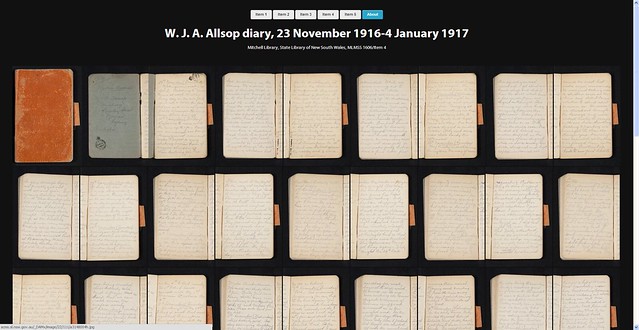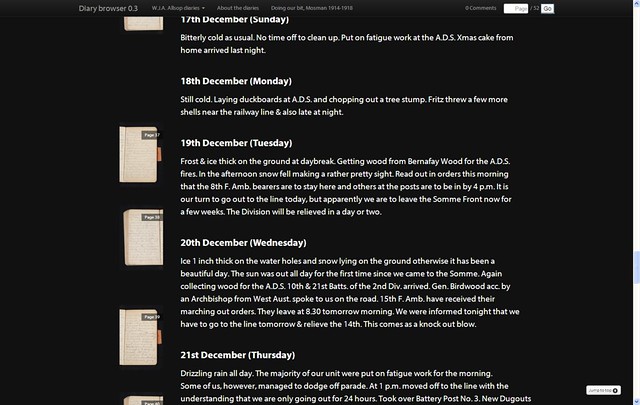The five diaries of stretcher bearer and despatch rider W.J.A. “Allan” Allsop at the Mitchell Library, collected in 1919 and now scanned and transcribed, are a fantastic resource. But they’re somewhat hidden within the State Library of NSW website and the viewing experience is not the best. See, for example, the album view and transcript of Item 4 on the SLNSW website. How can we bring the diary contents to life?
Tim Sherratt has re-imagined interfaces for viewing archival documents and he inspired me to have a bash at Python, a programming language well suited to working with text and web documents. The Programming Historian tutorial is a great place to start.
At first my aim was to reorder the transcripts by date (rather than page) and make them available in a Google Spreadsheet for the team to highlight key locations and events by day. This effort was too ambitious. The CSV format is unforgiving and the transcripts didn’t yet have the necessary structure and consistency.
Diary browser 0.1
Unlike the text and markup for the dates, the page numbers and associated anchor tags in the SLNSW transcripts were mostly consistent, allowing me to generate a visual page browser (again inspired by Tim Sherratt and his archive document walls).
- MLMSS 1606/Item 1 – 23 July 1915—1 July 1916
- MLMSS 1606/Item 2 – 2 July—13 September 1916
- MLMSS 1606/Item 3 – 14 September—22 November 1916
- MLMSS 1606/Item 4 – 23 November 1916—4 January 1917
- MLMSS 1606/Item 5 – 1 January—31 December 1917
Each diary’s pages are presented on a single web page, with a lightbox effect that allows you to move easily through pages with your mouse scrollwheel. At the very least, it’s a lot less clicking than viewing via the SLNSW site. And how good is the penmanship?
Diary browser 0.3
The second and third goes pulled dates out as subheaders and placed the scanned pages alongside the transcript.
- MLMSS 1606/Item 1 – 23 July 1915—1 July 1916
- MLMSS 1606/Item 2 – 2 July—13 September 1916
- MLMSS 1606/Item 3 – 14 September—22 November 1916
- MLMSS 1606/Item 4 – 23 November 1916—4 January 1917
- MLMSS 1606/Item 5 – 1 January—31 December 1917
You can more easily compare Allsop’s handwritten entries against the transcript, as well as link directly to a page. Breaks in the transcript caused by page numbers were removed and the text reflowed.
The text was also made larger for what is hopefully a more pleasant reading experience, although long form text is never much fun on a desktop computer. The diaries here should adapt to tablets and mobile phones but I’ve not had an opportunity to test these properly.
A comments box was dropped in via Disqus to allow anyone to leave a note.
Questions
How – or would you – add contextual information to the diary text?
For instance, on page 41 of Item 2, Allsop writes:
11 of our aeroplanes were up, one performing wonderfully. This was The Mad Major’s plane so we watched him very closely. He dived to within 100 ft. of the German trenches and opened up the machine gun. In this manner he carried on throughout the whole afternoon and Fritz had painted the sky black & white with shells but couldn’t hit him. The man is indeed a marvel.
Googling The Mad Major delivered this great newspaper piece from Trove dating from 1953.
Or, Allsop has a vivid description of Delville Wood. “This wood is indeed a picture. It changed hands 18 times & even now there are limbs lying about everywhere.” Here’s a photo of sunrise at Delville Wood via Instagram posted in the last 24 hours. The past may be a different country but the places are still there.
If a location was associated with each day’s entry in the HTML markup, could a map show the locations associated with content currently in the viewport?
Showing a map for each day might be overkill. But a dynamic map might work?

